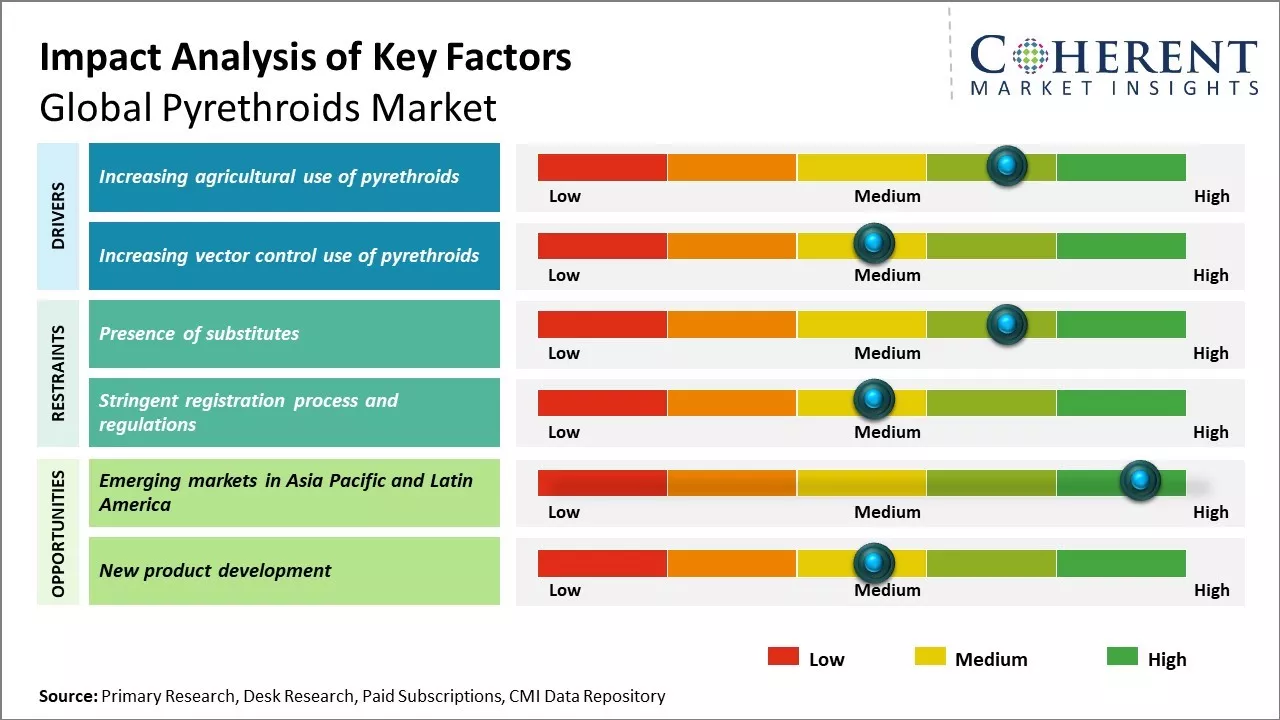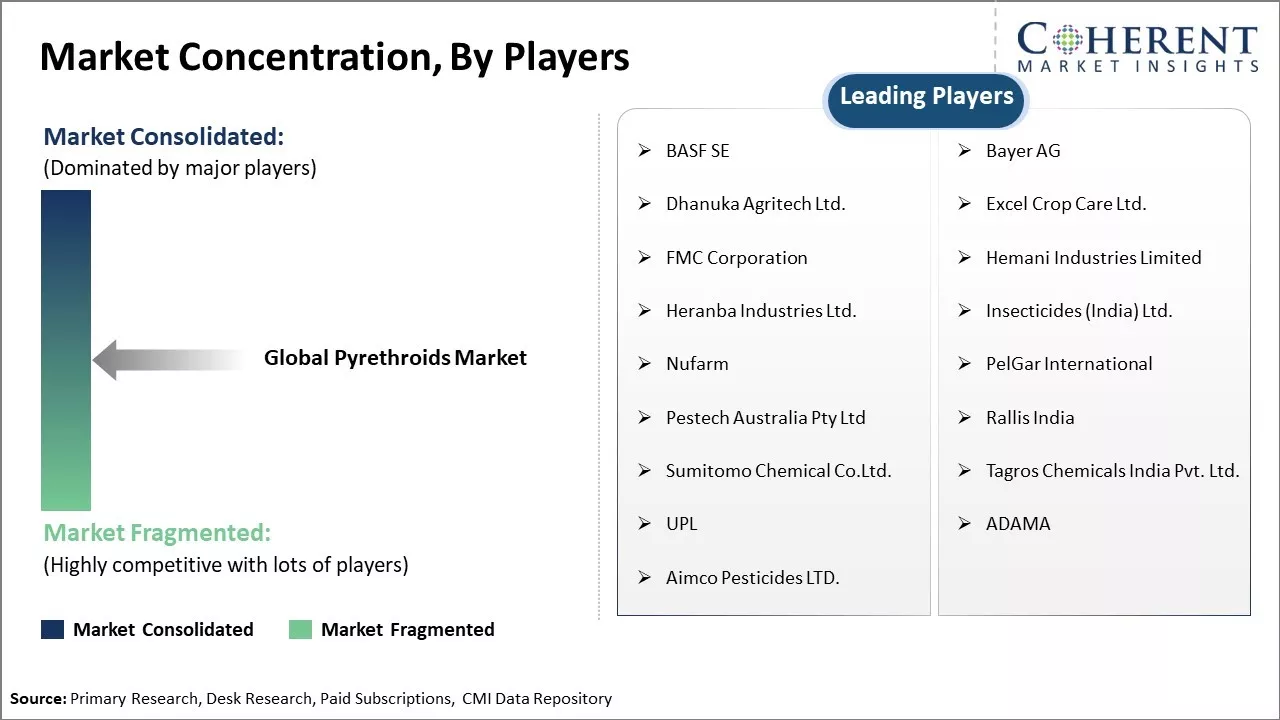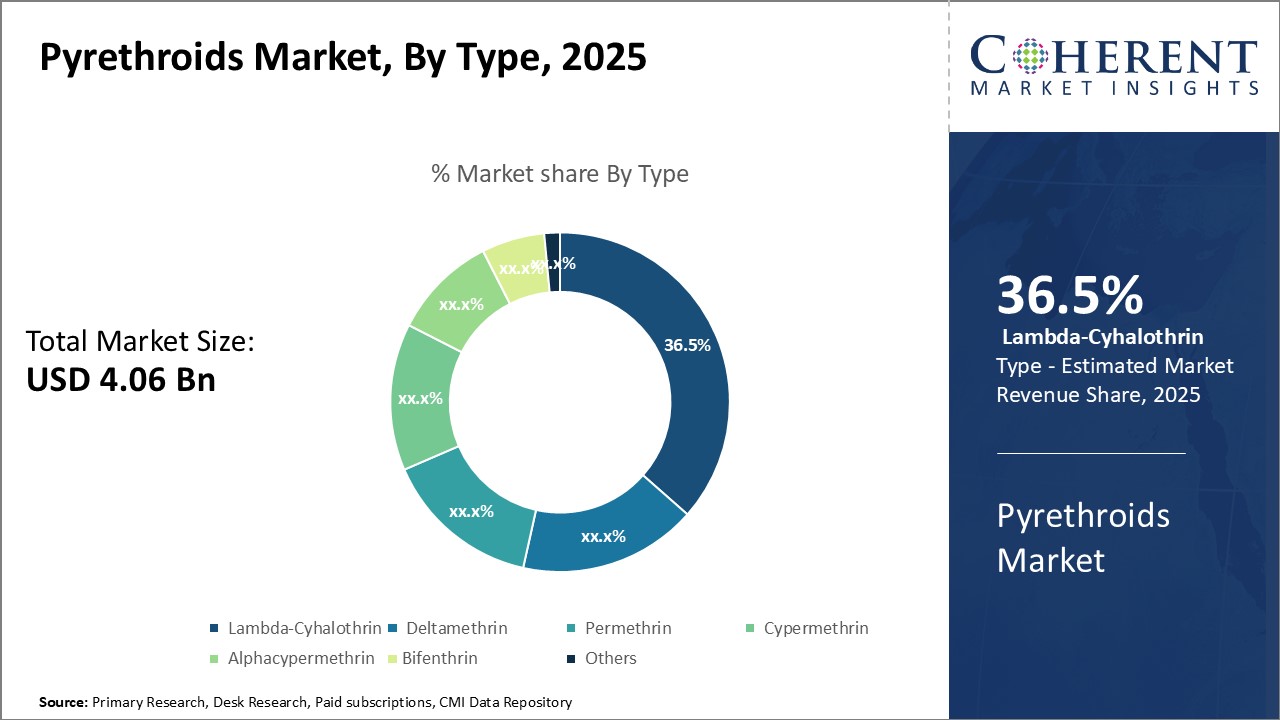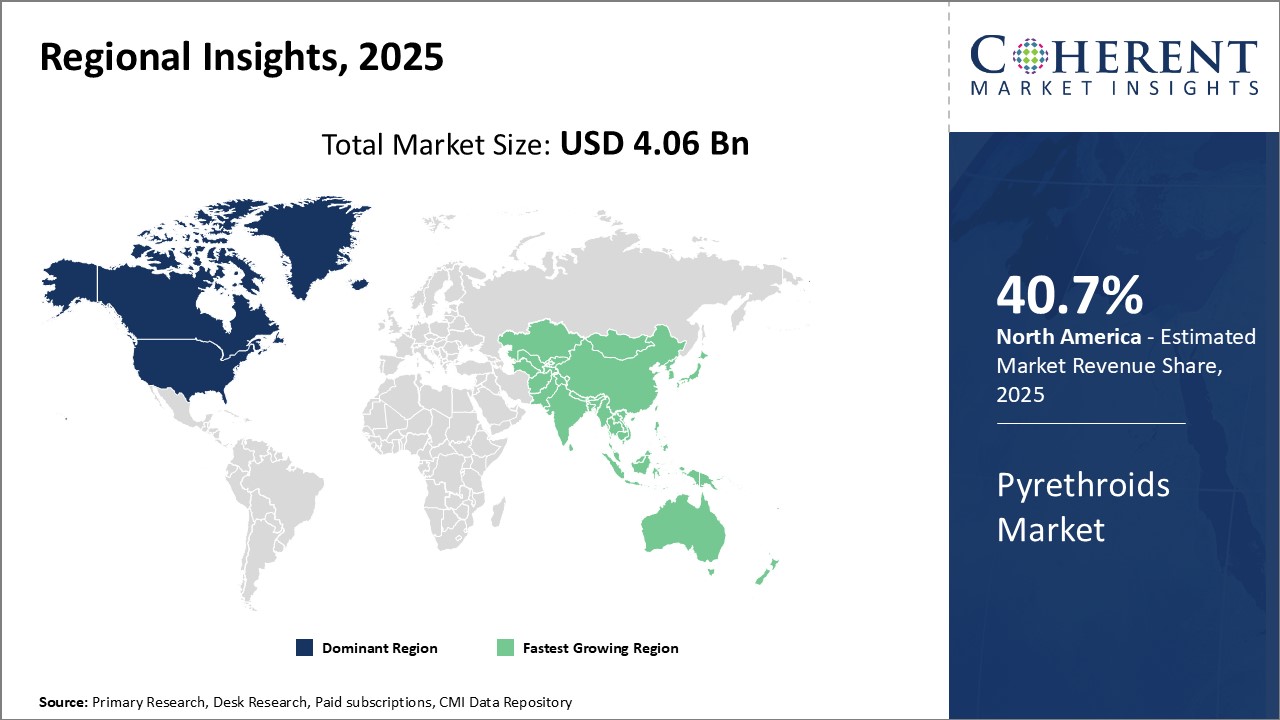The pyrethroids market is estimated to be valued at USD 4.06 Bn in 2025 and is expected to reach USD 5.68 Bn by 2032, exhibiting a compound annual growth rate (CAGR) of 4.9% from 2025 to 2032.

Discover market dynamics shaping the industry: Download Free Sample
Pyrethroid insecticides are widely used in agriculture globally due to their low mammalian toxicity and high efficacy against various insect pests. The increasing demand for food due to the rising global population has been driving the need for enhancing agricultural productivity, which, in turn, is boosting the adoption of pyrethroid insecticides. The agriculture segment accounts for the majority of demand for pyrethroids currently due to their widespread use in controlling various insect pests that damage crops. Within agriculture, the demand is the highest from the fruits & vegetables and cereals segments. However, with growing awareness and stringent regulations regarding the use of toxic chemicals in agriculture, the market is witnessing a shift towards more environment-friendly biopesticides. This is expected to slightly hamper the growth of the conventional pyrethroids market going ahead. Moreover, expanding applications in public health programs for mosquito control would provide new avenues of growth for the players in this market during the forecast period.
Increasing agricultural use of pyrethroids
Pyrethroids are being used increasingly in agricultural activities around the world. With growing populations and rising food demand, agricultural production is expanding rapidly. However, farmers are facing big challenges from pests and diseases that damage crops. Pyrethroid insecticides have proven to be an effective tool in protecting crops from a wide range of harmful insects. They are less toxic to humans and other mammals compared to older pesticides. Due to their low mammalian toxicity and high insecticidal potency, pyrethroids are preferred by many farmers.
As agriculture intensifies to meet rising food needs, pest problems are also increasing in both quantity and complexity. Many types of insects are developing resistance to conventional insecticides. Pyrethroids continue working against resistant insects better than old pesticides. Additionally, strict regulations restricting the use of highly hazardous pesticides are pushing farmers to adopt safer alternatives like pyrethroids. Regulatory authorities in major markets are promoting the use of reduced-risk pest control options. This supportive regulatory environment is boosting the sales of pyrethroid insecticides in agriculture.
Rising agricultural mechanization is another driver. Equipment and machinery used in various agricultural activities leaves more opportunities for insect infestation. Machinery parked for longer durations can accumulate insect colonies. Pyrethroids are proving effective in clearing insect infestations from agricultural implements and machinery. They are also used for protecting stored grains and crops from post-harvest losses due to insects. As agricultural practices modernize in developing nations, the protective use of pyrethroids is growing both pre-harvest and post-harvest.

Get actionable strategies to beat competition: Download Free Sample
Increasing vector control use of pyrethroids
Vector-borne diseases transmitted by mosquitoes, flies, and other insects continue posing serious health threats around the world. According to the World Health Organization, vector-borne pathogens account for over 17% of all infectious diseases. Diseases like malaria, dengue, Lyme disease, African sleeping sickness, and Zika are inflicting immense suffering. Effective control of disease spreading insects and parasites is critical for public health.
Pyrethroids have established themselves as one of the frontline weapons against vectors of diseases. They are widely used for indoor residual spraying and insecticide treated bed nets. Products containing pyrethroids are proven to provide lasting protective effect against mosquito bites when applied properly on surfaces.
Key Takeaways from Analyst:
Pyrethroids are widely used across various end-use industries such as the agricultural, commercial, and residential sectors. Growing demand for organic and environment-friendly crop protection solutions will drive the increased adoption of pyrethroid insecticides in the agricultural industry. However, regulations on the use of certain pyrethroids may restrain the market growth to some extent.
The Asia Pacific region currently dominates the pyrethroids market and the trend is likely to continue in the foreseeable future. Increasing agricultural activities and crop production in major countries of the region are the key factors responsible for market growth. North America is also a prominent regional market supported by high usage of pyrethroids for commercial pest control applications in the region.
The demand for alpha-cypermethrin and deltamethrin is expected to rise at a higher pace compared to other pyrethroids. This is due to their effectiveness in controlling a wide range of pests affecting agriculture. Manufacturers are investing in R&D to develop advanced pyrethroid formulations with better resistance management. They are also focusing on technologies that can minimize residue levels and enhance the safety profiles of pyrethroids.
Market Challenges: Presence of substitutes
One of the main challenges faced by the global adhesive tapes market is the availability of alternatives.
Market Opportunities: Emerging markets in Asia Pacific and Latin America
Focusing on developing economies presents a great opportunity for growth in the global adhesive.

Discover high revenue pocket segments and roadmap to it: Download Free Sample
Insights by Type: Lambda-Cyhalothrin's Superior Efficacy Drives Market Share
Lambda-Cyhalothrin has proven to be one of the most effective pyrethroid formulations for controlling a wide range of insect pests afflicting major agricultural crops. The Lambda-Cyhalothrin segment is expected to account for 36.5% of the market share in 2025. Its high insecticidal potency allows farmers to achieve effective pest management with smaller quantities of the active ingredient compared to other pyrethroids. This provides significant cost savings which boost its competitive advantage. Lambda-Cyhalothrin also has a favorable toxicological profile with minimal impact on non-target organisms like bees and low mammalian toxicity. Regulatory agencies have approved its use in many countries which has expanded its reach across global agricultural markets.
Another factor contributing to Lambda-Cyhalothrin's prominence is its broad spectrum of activity. It controls sucking and chewing insect pests across a diversity of crops from cereals and grains to fruits and vegetables. This wide insecticidal coverage eliminates the need to alternate with different products, simplifying pest management programs for farmers. Lambda-Cyhalothrin also persists longer on crops than some alternatives, providing weeks of residual protection against newly hatching pests. This enduring protection fosters strong farmer loyalty to the product.
Lambda-Cyhalothrin's chemical and physical properties further augment its pest control attributes. It has high lipophilicity allowing thorough penetration of plant surfaces and rapid knockdown of insects. Its photostability also prevents degradation from sunlight, maintaining insecticidal potency even under conditions of high UV exposure. These advantageous formulation qualities maximize on-crop protection and optimize pest eradication.
Insights by Application: Importance in protecting high-value food crops from devastating yield losses
Agriculture dominates the application segment for pyrethroids due to their importance in protecting high-value food crops from devastating yield losses. The agriculture segment is expected to account for 41.2% of the market share in 2025. Most farmers rely on effective insecticides to safeguard staple commodities from pest infestations. Pyrethroids are favored for their broad insecticidal activity, controlling the myriad insect pests and vectors that plague agricultural fields. They target damaging species that plague important cereals, oilseeds, fruits, and vegetables.
Major drivers of pyrethroid use in the agricultural sector include growing global food demand and the need to boost agricultural productivity. Escalating population pressures are shrinking available arable land resources, necessitating even higher crop yields from existing farmland. At the same time, climate change is disrupting weather patterns and expanding the habitats of agricultural insect pests. This threatens global food security if pests are left uncontrolled. Pyrethroids play a vital role in stabilizing food production through reliable pest suppression. They are valued for their potent yet selective activity which protects harvests without harming farms' delicate ecological balance.
Government initiatives in several countries also stimulate pyrethroid adoption for farming. Subsidies and educational programs encourage integrated pest management using reduced-risk products. As public concerns rise over chemical pesticide hazards, regulatory support for "softer" options like pyrethroids boosts their usage in sustainable agriculture programs. All these multifaceted factors intersect to entrench pyrethroids as frontline defenders of world's crop yields and collective food supply.

Need a Different Region or Segment? Download Free Sample
North America has dominated the global pyrethroids market for many years due to strong agricultural and pest control industries in the region. The region is expected to account for 40.7% of the market share in 2025. The large scale farming operations and extensive use of pesticides in crops such as corn, soybean, and wheat have contributed to North America being the largest consumer of pyrethroids. Several leading manufacturers of insecticides and pest control products are also headquartered in the U.S. and Canada, allowing for the easy availability of a wide pyrethroids product range. In addition, the high disposable incomes and growing pest control requirements in residential and commercial sectors across the U.S. have further boosted the pyrethroids demand over the years.
A key region exhibiting rapid growth in the pyrethroids market is Asia Pacific. Various factors are driving the market growth in Asia Pacific. The growing population levels along with expanding urban infrastructure and construction activities have raised insect infestation risks, increasing the need for pest control measures. Asia Pacific is also a major agricultural production base, with vast tracts of land under rice, fruits and vegetables cultivated across nations such as India and China. This has surged the pyrethroids consumption for crop protection. Moreover, several pyrethroids producers have set up manufacturing bases in Asia Pacific countries to take advantage of lower costs and cater to the rising local and export demand.
Pyrethroids Market Report Coverage
| Report Coverage | Details | ||
|---|---|---|---|
| Base Year: | 2024 | Market Size in 2025: | USD 4.06 Bn |
| Historical Data for: | 2020 To 2024 | Forecast Period: | 2025 To 2032 |
| Forecast Period 2025 to 2032 CAGR: | 4.9% | 2032 Value Projection: | USD 5.68 Bn |
| Geographies covered: |
|
||
| Segments covered: |
|
||
| Companies covered: |
BASF SE, Bayer AG, Dhanuka Agritech Ltd., Excel Crop Care Ltd., FMC Corporation, Hemani Industries Limited, Heranba Industries Ltd., Insecticides (India) Ltd., Nufarm, PelGar International, Pestech Australia Pty Ltd, Rallis India, Sumitomo Chemical Co.Ltd., Tagros Chemicals India Pvt. Ltd., UPL, ADAMA, and Aimco Pesticides LTD. |
||
| Growth Drivers: |
|
||
| Restraints & Challenges: |
|
||
Uncover macros and micros vetted on 75+ parameters: Get instant access to report
*Definition: The pyrethroids market involves the production, distribution, and sale of synthetic versions of natural pyrethrins. Pyrethrins are toxins found in chrysanthemum flowers that have insecticidal properties and are used to control a wide range of pests. Some examples of pyrethroids used as insecticides include permethrin, cypermethrin, deltamethrin, and allethrin. They are commonly applied in agriculture to protect crops, in public health programs to control disease-carrying insects, and for domestic pest control in homes and buildings. The global pyrethroids market has been growing steadily due to their low toxicity to mammals and widespread applicability.
Share
Share
About Author
Vidyesh Swar is a seasoned Consultant with a diverse background in market research and business consulting. With over 6 years of experience, Vidyesh has established a strong reputation for his proficiency in market estimations, supplier landscape analysis, and market share assessments for tailored research solution. Using his deep industry knowledge and analytical skills, he provides valuable insights and strategic recommendations, enabling clients to make informed decisions and navigate complex business landscapes.
Missing comfort of reading report in your local language? Find your preferred language :
Transform your Strategy with Exclusive Trending Reports :
Frequently Asked Questions
Joining thousands of companies around the world committed to making the Excellent Business Solutions.
View All Our Clients